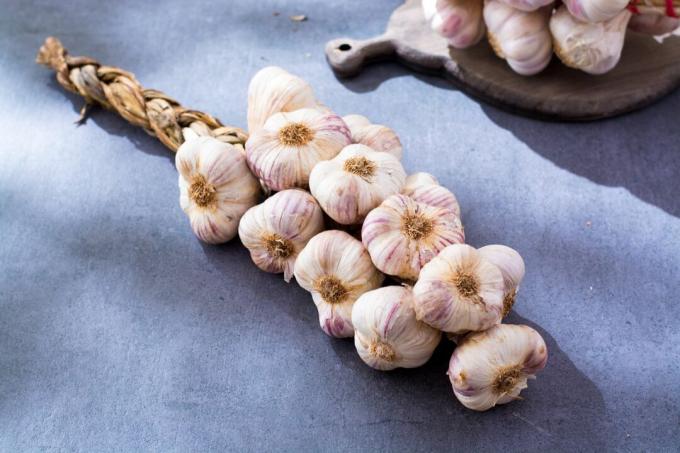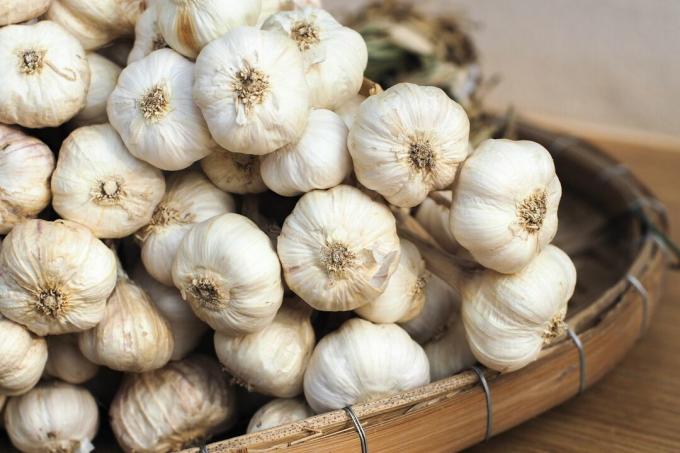Harvesting garlic and storing it properly is not always easy. These tips and tricks will help with drying, storing, and pickling garlic.

garlic (Allium sativum) can be found in almost every kitchen and it can easily be grown in your own garden. In order for cultivation to be successful, correct harvesting and storage is important in order to preserve the popular "tuber". The right approach is therefore required, especially with garlic, so that the garlic cloves stay fresh and the aroma is preserved. The following instructions are intended to help you do everything right when harvesting and storing garlic.
contents
- harvest garlic
- dry garlic
-
Storing Garlic: Pickling, Freezing or at Room Temperature?
- Storage at room temperature
- Freezing garlic: opinions differ
- Put the garlic
harvest garlic
Garlic is usually planted in autumn and/or spring. Therefore, the times of harvest are also different: If the garlic is planted in autumn, it can be harvested as early as July. If planted in spring, it takes a few weeks longer, the harvest time is in late summer to autumn. In addition to the earlier harvest, planting the garlic cloves in autumn also offers another advantage: the longer growth period means that the yield is higher than planting in the spring.

Fortunately, the plant shows when the right time to harvest has been reached by looking at its leaves: it can be harvested as soon as the upper third of the plant wilts. However, you should not wait too long, otherwise the "bulb" will split into individual cloves of garlic. This means that it can no longer be hung up to dry afterwards. To harvest the garlic, the plants are pulled out of the ground as a whole as carefully as possible. Damage to the garlic bulb reduces shelf life.
dry garlic
Drying the garlic is very important as the first step in preserving the cloves for a longer period of time. After harvesting, the freshly grown plants and bulbs are laid out on the bed to dry for a few days – provided that the weather is dry, of course. It is then a good idea to hang up the garlic. It can be preserved very well by plaiting the greens of several garlic plants into a braid and hanging them in a cool, dark place. When selecting the place to dry, care should be taken to ensure good ventilation, otherwise mold growth is possible. For drying the garlic braids, for example, the garage or a canopy with good ventilation are ideal. Garlic should not be washed after harvest due to mold!
After one to a maximum of two months, the garlic is usually sufficiently dry. This can be recognized by the wrinkled skin and papery consistency of the foliage.

These tips should be followed when drying garlic:
- Dry on the bed after harvest
- Braid the greens together with the onion
- Hang in a well-ventilated, shaded and cool place
- Do not wash garlic after harvesting!
Storing Garlic: Pickling, Freezing or at Room Temperature?
After the garlic has been successfully dried, it is time to store the aromatic "bulbs" properly. After drying on the braid, a garlic bulb can easily be cut off the bunch. First, the root hairs and several layers of the skin should be removed. There are a variety of methods for storing garlic properly and extending its shelf life. The following methods work well for storage.
Storage at room temperature
Garlic can be stored very well at room temperature for several weeks to months. A basket or an airy bag is suitable for this. Direct sunlight should be avoided as it increases premature sprouting of the garlic cloves. Good ventilation is also important during storage, so it should never be stored in a closed container. Otherwise there is a risk of mold growth. The same applies to storage in the refrigerator: due to the humidity, the garlic cloves spoil quickly and should therefore not be kept there under any circumstances. The garlic also loses its aroma as a result.

The following information should be observed when storing at room temperature:
- Airy storage (ex. B. basket or open bag)
- No direct sunlight
- Not in a closed container or refrigerator!
Freezing garlic: opinions differ
Another method of preserving food is freezing. This type of storage is also possible for garlic. To do this, wrap the garlic bulbs, either whole or chopped, in plastic wrap and place in the freezer. The disadvantage of this technique is that the garlic loses its taste when stored in the refrigerator. Still, freezing is great for people who don't use a lot of garlic in their cooking.
Put the garlic
A popular way to preserve garlic is to pickle it in oil. Olive oil is the best for this. For pickling, the cloves are first peeled and then filled into a clean glass together with the oil. The toes should be completely covered with oil. Alternatively, the cloves can be heated in oil at 90 °C for a few minutes beforehand. The jar is then sealed tightly and placed in the fridge or freezer.

But beware: Keeping it in a cool environment is very important as the bacterium Clostridium botulinum grows at room temperature. Bacteria of this type lead to food poisoning, so it is essential to ensure the necessary cooling!
With these tips, pickling garlic is child’s play:
- Peel garlic cloves
- Pour into a jar with olive oil and seal
- Be sure to store in the fridge or freezer, otherwise there is a risk of poisoning!
In case you haven't had enough of garlic, this article has a few curious facts about garlic.



